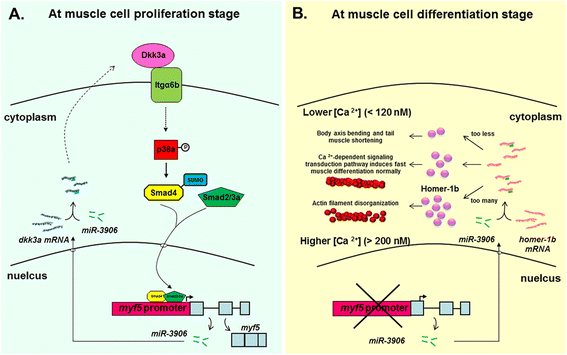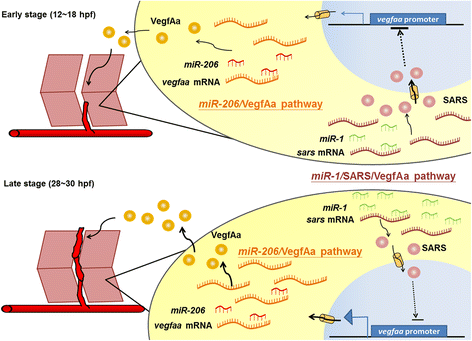Zebrafish and Medaka: new model organisms for modern biomedical research
- PMID: 26822757
- PMCID: PMC4730764
- DOI: 10.1186/s12929-016-0236-5
Zebrafish and Medaka: new model organisms for modern biomedical research
Abstract
Although they are primitive vertebrates, zebrafish (Danio rerio) and medaka (Oryzias latipes) have surpassed other animals as the most used model organisms based on their many advantages. Studies on gene expression patterns, regulatory cis-elements identification, and gene functions can be facilitated by using zebrafish embryos via a number of techniques, including transgenesis, in vivo transient assay, overexpression by injection of mRNAs, knockdown by injection of morpholino oligonucleotides, knockout and gene editing by CRISPR/Cas9 system and mutagenesis. In addition, transgenic lines of model fish harboring a tissue-specific reporter have become a powerful tool for the study of biological sciences, since it is possible to visualize the dynamic expression of a specific gene in the transparent embryos. In particular, some transgenic fish lines and mutants display defective phenotypes similar to those of human diseases. Therefore, a wide variety of fish model not only sheds light on the molecular mechanisms underlying disease pathogenesis in vivo but also provides a living platform for high-throughput screening of drug candidates. Interestingly, transgenic model fish lines can also be applied as biosensors to detect environmental pollutants, and even as pet fish to display beautiful fluorescent colors. Therefore, transgenic model fish possess a broad spectrum of applications in modern biomedical research, as exampled in the following review.
Figures


Similar articles
-
Excision of the tol2 transposable element of the medaka fish, Oryzias latipes, in zebrafish, Danio rerio.Gene. 1998 Dec 28;225(1-2):17-22. doi: 10.1016/s0378-1119(98)00537-x. Gene. 1998. PMID: 9931412
-
Small teleost fish provide new insights into human skeletal diseases.Methods Cell Biol. 2017;138:321-346. doi: 10.1016/bs.mcb.2016.09.001. Epub 2016 Oct 8. Methods Cell Biol. 2017. PMID: 28129851 Review.
-
Zebrafish and Medaka: Important Animal Models for Human Neurodegenerative Diseases.Int J Mol Sci. 2021 Oct 5;22(19):10766. doi: 10.3390/ijms221910766. Int J Mol Sci. 2021. PMID: 34639106 Free PMC article. Review.
-
Low-temperature embryo incubation suppresses off-target mutagenesis during CRISPR-Cas9 genome editing in medaka (Oryzias latipes) and zebrafish (Danio rerio).Transgenic Res. 2025 Mar 25;34(1):15. doi: 10.1007/s11248-025-00434-z. Transgenic Res. 2025. PMID: 40131558
-
Faithful expression of living color reporter genes in transgenic medaka under two tissue-specific zebrafish promoters.Dev Dyn. 2005 Oct;234(2):387-92. doi: 10.1002/dvdy.20491. Dev Dyn. 2005. PMID: 16124005
Cited by
-
Oxidative stress and apoptotic effects of copper and cadmium in the zebrafish liver cell line ZFL.Toxicol Rep. 2020 Jul 4;7:822-835. doi: 10.1016/j.toxrep.2020.06.012. eCollection 2020. Toxicol Rep. 2020. PMID: 32670800 Free PMC article.
-
The Geometric World of Fishes: A Synthesis on Spatial Reorientation in Teleosts.Animals (Basel). 2022 Mar 30;12(7):881. doi: 10.3390/ani12070881. Animals (Basel). 2022. PMID: 35405870 Free PMC article. Review.
-
Investigating Cutaneous Squamous Cell Carcinoma in vitro and in vivo: Novel 3D Tools and Animal Models.Front Med (Lausanne). 2022 May 9;9:875517. doi: 10.3389/fmed.2022.875517. eCollection 2022. Front Med (Lausanne). 2022. PMID: 35646967 Free PMC article. Review.
-
Circulating MicroRNAs Indicative of Sex and Stress in the European Seabass (Dicentrarchus labrax): Toward the Identification of New Biomarkers.Mar Biotechnol (NY). 2023 Oct;25(5):749-762. doi: 10.1007/s10126-023-10237-0. Epub 2023 Aug 15. Mar Biotechnol (NY). 2023. PMID: 37581865
-
Maximizing single cell dissociation protocol for individual zebrafish embryo.MethodsX. 2024 Sep 14;13:102958. doi: 10.1016/j.mex.2024.102958. eCollection 2024 Dec. MethodsX. 2024. PMID: 39329153 Free PMC article.
References
-
- Hackett PB. The molecular biology of transgenic fish. In: Hochachka PW, Mommsen TP, editors. Biochemistry and Molecular Biology of Fishes. Amsterdam: Elsevier Science; 1993. pp. 207–240.
Publication types
MeSH terms
LinkOut - more resources
Full Text Sources
Other Literature Sources

